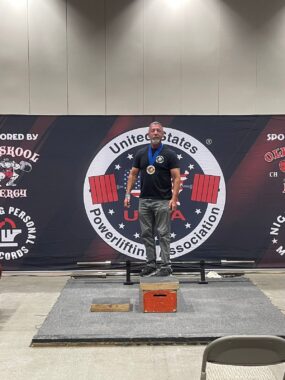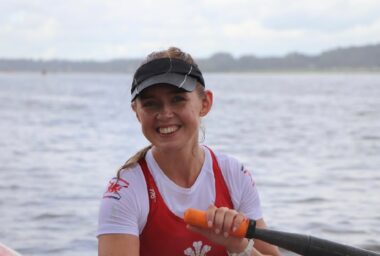The importance of finding an enjoyable form of exercise
The Paris Olympics reminded me that there are many options to choose from

Like many, I’ve enjoyed watching incredible athletes showcase their abilities at this year’s Paris Olympics and Paralympics.
The Olympic Games always remind me of all the forms athleticism can take. There are countless sports out there that are all recognized as valid and worthy endeavors on a global stage. Each event is a unique celebration of what the human body can achieve with talent and considerable hard work.
It’s cliché, but I find it inspiring. For me, it’s a reminder that, although I don’t aspire to be a world-class athlete, there are surely some physical activities out there that suit me — ones I can perform and find passion and joy in.

John Nixon is a bodybuilder with CMT. (Courtesy of John Nixon)
In the Charcot-Marie-Tooth disease (CMT) community, it’s a common refrain that “movement is medicine.” After all, even for able-bodied folks, physical activity is important to overall health and well-being. As the adage says, you either “use it or lose it.” But those of us with neurological disorders can experience worse outcomes from inactivity, as our losses can be more profound.
However, for many CMTers, finding a form of exercise we enjoy can be a challenge. I’ve never naturally excelled at any physical activity, and I don’t have many fond memories of gym class from childhood. In group activities and team sports, I find it difficult to imagine that I’m not dragging others down.
Beyond the psychological and emotional hurdles, there are some activities I just can’t do. My limited ankle mobility prevents me from squatting safely. My current level of proprioception makes combat sports even more dangerous. And my inherent clumsiness makes hiking and climbing extra challenging.

Morris Angel is a powerlifter with CMT. (Courtesy of Morris Angel)
Nonetheless, I’ve recently found a lot of joy in making progress with simple exercise movements, which a personal trainer adapted for my limited mobility. Last year, I was surprised to find I could do a pullup — something I had long assumed was unattainable for me.
The first time I performed one, I was so in awe of what I was capable of that I likened it to discovering I could fly.
I don’t know if my fascination with my current workout regimen will last my entire life. However, I’m confident that, with intention and experimentation, I’ll always be able to find an activity that’s suitable and enjoyable for me.
I recently reached out to other CMTers who have found a sport that resonates with them. Here’s what they shared about their chosen activity:
“I started bodybuilding to help improve the symptoms of CMT. I keep it up because I feel much fitter and healthier. The bonus is that I also look aesthetically better.” — John Nixon
“I like powerlifting because even with progressed CMT, I am able to do it. It is a super-inclusive sport that allows me to compete. It is a healthy lifestyle that carries over well into my spiritual practices such as qigong. When I walked my funny little walk into gym for the first time, I was told, ‘Welcome. You are right where you need to be.'” — Morris Angel

Rebekah Knight is a rower with CMT. (Courtesy of Rebekah Knight)
“Rowing rewards hard work and consistency, both of which are my main strengths. I’m not the biggest, strongest, or tallest, but I can stick to a program and put the work in. There is no running or jumping required and I can push myself hard without worrying about tripping or hurting my ankles. Even when training in a single, the group I train with are so supportive that it always feels like I’m part of a team, which is so welcome after years of going to the gym on my own. It’s so freeing to be able to move with speed and power on water in a way that I can’t on land.” — Rebekah Knight
Note: Charcot-Marie-Tooth News is strictly a news and information website about the disease. It does not provide medical advice, diagnosis, or treatment. This content is not intended to be a substitute for professional medical advice, diagnosis, or treatment. Always seek the advice of your physician or other qualified health provider with any questions you may have regarding a medical condition. Never disregard professional medical advice or delay in seeking it because of something you have read on this website. The opinions expressed in this column are not those of Charcot-Marie-Tooth News or its parent company, Bionews, and are intended to spark discussion about issues pertaining to Charcot-Marie-Tooth.






Christine Wodke
I am an athlete with CMT. I am lucky because I still run, bike, and ski. I started as a rower.
Swimming and water exercise are something many with CMT can do. Also, yoga is a good option since it can be adapted to any limits even in a chair. I agree it is important to find something you like and continue to challenge yourself. I can be found at run4cmt.com if you want to learn more about me. I have dedicated my triathlon and running events to raising awareness of CMT.
Anneke Werf
I discovered scuba diving. I have now made almost 1300 dives at home and abroad. https://duikeninbeeld.tv/duiken-met-een-handicap-een-uur-gezond/
Cliff Love
Yes , movement is vital to sustaining a positive and "healthy" life with CMT. As well as finding the passion for exercise and fitness the important point left out of the article is finding the "sweet spot" for the amount and intensity of exercising. Personally, swimming is my go to exercise, preferably in the Sea. I live in close proximity to a great area by the Mediterranean, Neve Yam , Israel . I'm currently up to swimming about 1.5 miles, 5 times a week if the sea permits - with a front snorkel, hand paddles and short swimmer flippers. The relaxation of the meditative stretching accompanied with breathing is invigorating. The difference of the gradational pull on the body while in the water also has a positive soothing effect on the compromised nervous system. The swimming keeps me mentally and physically in the best possible shape . I wish for all CMT'ers that you find your "SWEET SPOT"!
Samuel O. Spooner
I am an 87-year-old wheelchair-disabled man with advanced cmt1a. I had symptoms at birth. I credit EXERCISE for my longevity. Ironically, long-distance walking has always been the only option I had for exercise. I now live in a large apartment complex. The hallways here are extremely long. I remain ambulatory, but only on a wheeled walker. I walk 3/8 of a mile on my walker, twice every day. I have made many friends out walking. I plan to live well into my nineties. That won't happen without continued daily exercise. I am also a published author of two novels. For those interested, my website is positiveoutlooknovels.com.
Dorsey Cartwright
Samual, given your story and current ability, I strongly suggest you go to Alinker.com amd look at the mobility walking bikes (not motorized). They may just be up your alley and take you into your 90's (100's?)
I love mine, just got back from the Rockies where I traveled the path around Lake Louise on my Alinker!
Robyn Cooper
I am 76 years old unable to walk as my legs won't move, also have no balance if I don't hang onto something I fall. I was wondering if there was a way I could exercise with help of my family. Or occupational therapy many thanks
Alex Noone
I am 52 with type A1 and have a personal trainer two days a week, cycle to and from work and do yoga. I push myself to do these things as without them, I would be tripping, falling over, tearing ligaments, fracturing bones, etc.